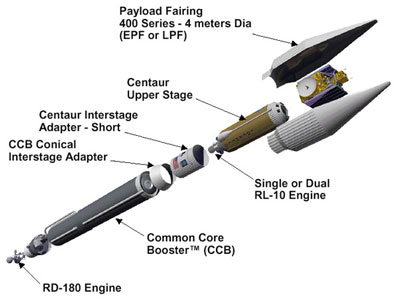
Posted on 01/17/2006 8:36:57 AM PST by Textide
The launch is scheduled from Cape Canaveral, FL at 1:14pm Eastern.
Spaceflightnow.com Mission Status



New Horizons science goals
FROM MISSION PRESS KIT
Posted: January 8, 2006
Based largely on what the scientific community wanted to learn about Pluto and Charon, NASA prioritized its science goals for Pluto-system exploration in three categories:
Required
Characterize the global geology and morphology of Pluto and Charon
Map surface composition of Pluto and Charon
Characterize the neutral atmosphere of Pluto and its escape rate
Important
Characterize the time variability of Pluto's surface and atmosphere
Image Pluto and Charon in stereo
Map the terminators (day/night lines) of Pluto and Charon in high resolution
Map the composition of selected areas of Pluto and Charon at high resolution
Characterize Pluto's ionosphere and solar wind interaction
Search for neutral species (including hydrocarbons and nitriles) in Pluto's upper atmosphere
Search for an atmosphere around Charon
Determine bolometric bond albedos for Pluto and Charon
Map the surface temperatures on Pluto and Charon
Desired
Characterize the energetic particle environment of Pluto and Charon
Refine bulk parameters (radii, masses, densities) and orbits of Pluto and Charon
Search for magnetic fields of Pluto and Charon
Search for additional satellites and rings
NASA defines mission success as meeting the "required" objectives. With its full science payload -- three optical instruments, two plasma instruments, a radio science receiver/radiometer and a dust sensor - New Horizons expects to exceed these requirements, meeting or addressing all of the objectives in each category.
Bump!
Gosh, I hope I make it past the year of 2018!
11:19 a.m. - We are now at T-1 hours, 55 minutes and counting.
11:15 a.m. - Cooling or "chilldown" of the mobile launch platform has begun. This will acclimate the rocket for the beginning of the supercold propellents entering the rocket once the tanking begins.
11:14 a.m. - We are at T-2 hours and counting for liftoff of New Horizons.
11:07 a.m. - A preliminary weather briefing has indicated winds are at 25 knots right now, with 33 knots being a constraint for launch.
Its supposed to arrive by 2015 :)
they moved the time up. very windy here today
KTTS 171511 18015G25KT 9999 SCT030 BKN250 QNH2997INS
TEMPO 1522 18025G35KT
BECMG 2122 22018G25KT 9999 FEW030 SCT100 BKN200 QNH2991INS
BECMG 0405 24018G25KT 9999 VCSH SCT030 BKN100 BKN200 QNH2992INS T27/19Z T12/10Z 1559
Winds are out of the south at 19kts gusting to 28kts. Recent peak winds are 36kts.
psst launch is 13:24:00 EST
Statement due mostly by my desire to see KBO's past Pluto's orbit, which will come later than 2015.
But anywho, I hope I make it past 2015 ;)
Excellent! Thanks so much for the thread.
Is this the one the moonbats have their panties twisted over because of some plutonium on the craft?
Can you believe that's only 12 years from now?
...and that's only 9 away...
As they arrive, they'll see mostly sunny skies and a nice crisp temperature of about -410 degrees...
Yup
Here's wishing it well!
What is it about the propulsion system that will enable New Horizons to travel so fast? It took Apollo a few days to reach the moon; New Horizons will do it in 9 hours.
Neptune's large moon Triton hold the record for lowest measured temperature in a natural environmnet (a few degrees above absolute zero). Pluto or Charon may break that record.
Jan 6: Protest Planned for Pluto Spacecraft
The Global Network Against Weapons & Nuclear Power in Space of Brunswick, Maine has called for a demonstration at Cape Canaveral Air Force Station in Florida on Jan. 7 from 11:00 am to 1:00 pm EST (1600-1800 GMT).
The protest will highlight opposition to NASA’s planned New Horizons launch on January 17 that will carry a cache of plutonium to power the Pluto-bound probe’s radioisotope thermoelectric generator (RTG).
To be launched by an Atlas 5 booster, New Horizons will head out on a long distance journey to shoot past Pluto in 2015. After that flyby, the New Horizons probe -- given NASA-approved extended mission money -- is to study still-to-be selected Kuiper Belt objects, ancient, icy and rocky mini-worlds that are leftovers from the formation of the solar system.
In a statement from Global Network Coordinator, Bruce Gagnon: “We might have escaped Cassini, we might escape New Horizons, but with plans to put nuclear reactors on the Moon to power bases there in the coming years, NASA will be launching a host of these missions. One thing we have learned is that sooner or later, space technology can fail.”
Disclaimer: Opinions posted on Free Republic are those of the individual posters and do not necessarily represent the opinion of Free Republic or its management. All materials posted herein are protected by copyright law and the exemption for fair use of copyrighted works.